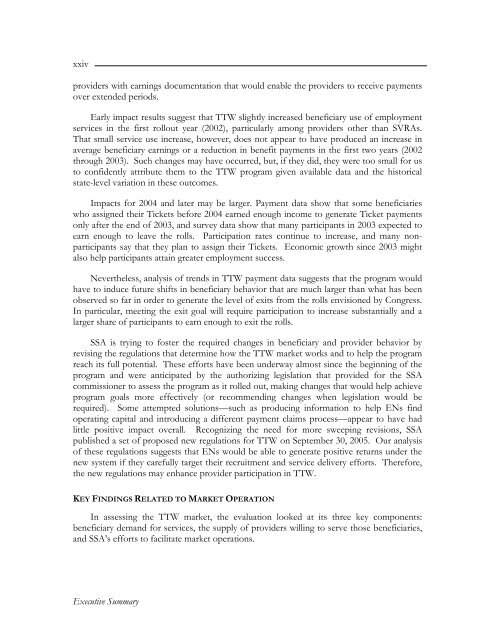Evaluation of the Ticket To Work Program - Mathematica Policy ...
Evaluation of the Ticket To Work Program - Mathematica Policy ...
Evaluation of the Ticket To Work Program - Mathematica Policy ...
You also want an ePaper? Increase the reach of your titles
YUMPU automatically turns print PDFs into web optimized ePapers that Google loves.
xxiv<br />
providers with earnings documentation that would enable <strong>the</strong> providers to receive payments<br />
over extended periods.<br />
Early impact results suggest that TTW slightly increased beneficiary use <strong>of</strong> employment<br />
services in <strong>the</strong> first rollout year (2002), particularly among providers o<strong>the</strong>r than SVRAs.<br />
That small service use increase, however, does not appear to have produced an increase in<br />
average beneficiary earnings or a reduction in benefit payments in <strong>the</strong> first two years (2002<br />
through 2003). Such changes may have occurred, but, if <strong>the</strong>y did, <strong>the</strong>y were too small for us<br />
to confidently attribute <strong>the</strong>m to <strong>the</strong> TTW program given available data and <strong>the</strong> historical<br />
state-level variation in <strong>the</strong>se outcomes.<br />
Impacts for 2004 and later may be larger. Payment data show that some beneficiaries<br />
who assigned <strong>the</strong>ir <strong>Ticket</strong>s before 2004 earned enough income to generate <strong>Ticket</strong> payments<br />
only after <strong>the</strong> end <strong>of</strong> 2003, and survey data show that many participants in 2003 expected to<br />
earn enough to leave <strong>the</strong> rolls. Participation rates continue to increase, and many nonparticipants<br />
say that <strong>the</strong>y plan to assign <strong>the</strong>ir <strong>Ticket</strong>s. Economic growth since 2003 might<br />
also help participants attain greater employment success.<br />
Never<strong>the</strong>less, analysis <strong>of</strong> trends in TTW payment data suggests that <strong>the</strong> program would<br />
have to induce future shifts in beneficiary behavior that are much larger than what has been<br />
observed so far in order to generate <strong>the</strong> level <strong>of</strong> exits from <strong>the</strong> rolls envisioned by Congress.<br />
In particular, meeting <strong>the</strong> exit goal will require participation to increase substantially and a<br />
larger share <strong>of</strong> participants to earn enough to exit <strong>the</strong> rolls.<br />
SSA is trying to foster <strong>the</strong> required changes in beneficiary and provider behavior by<br />
revising <strong>the</strong> regulations that determine how <strong>the</strong> TTW market works and to help <strong>the</strong> program<br />
reach its full potential. These efforts have been underway almost since <strong>the</strong> beginning <strong>of</strong> <strong>the</strong><br />
program and were anticipated by <strong>the</strong> authorizing legislation that provided for <strong>the</strong> SSA<br />
commissioner to assess <strong>the</strong> program as it rolled out, making changes that would help achieve<br />
program goals more effectively (or recommending changes when legislation would be<br />
required). Some attempted solutions—such as producing information to help ENs find<br />
operating capital and introducing a different payment claims process—appear to have had<br />
little positive impact overall. Recognizing <strong>the</strong> need for more sweeping revisions, SSA<br />
published a set <strong>of</strong> proposed new regulations for TTW on September 30, 2005. Our analysis<br />
<strong>of</strong> <strong>the</strong>se regulations suggests that ENs would be able to generate positive returns under <strong>the</strong><br />
new system if <strong>the</strong>y carefully target <strong>the</strong>ir recruitment and service delivery efforts. Therefore,<br />
<strong>the</strong> new regulations may enhance provider participation in TTW.<br />
KEY FINDINGS RELATED TO MARKET OPERATION<br />
In assessing <strong>the</strong> TTW market, <strong>the</strong> evaluation looked at its three key components:<br />
beneficiary demand for services, <strong>the</strong> supply <strong>of</strong> providers willing to serve those beneficiaries,<br />
and SSA’s efforts to facilitate market operations.<br />
Executive Summary
















